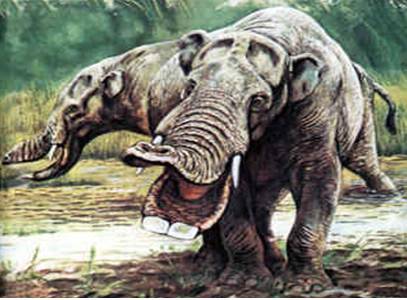 |
 |
 |
 |
 |
Produced
by the Population Genetics and Evolution class, Furman University |
||||
 |
 |
 |
 |
 |
Produced
by the Population Genetics and Evolution class, Furman University |
||||
 |
The
Neogene: Gomphotheres |
 |
||
| Gomphotheres
were a group of ancient elephants that were best known for possessing
both upper and lower tusks. These ancient elephants reached a height of
approximately eight feet and possessed elongated skulls with tusks that
were low to the ground. The upper tusks were straight and possessed distinctive
enamel bands while their lower tusks were flattened and paired together
like a shovel. Also, the chewing surfaces of their molars contained distinctive
clover patterns called “trefoils” that distinguished them
from other ancient elephants (Fossil Treasures of Florida 2010). Their
feeding habits have been debated as to whether they used their lower tusks
to scoop up water plants or if they were used as specialized cutting utensils
for vegetation (Lambert 1992). An interesting and recent archeological
find in 2007 has provided evidence that these creatures may have interacted
with early humans and were hunted by them. The find in the northern Mexican
state of Sonora revealed Gomphothere bones associated with prehistoric
human stone tools (Van Tuerenhout 2009). This find may prove that Gomphotheres
existed alongside mammoths and saber tooth tigers during the early history
of man. Page by Iggy Gaska |
 |
| Artists rendition of two ancient Gomphotheres. Picture From: Fossil Treasures of Florida | |
| Van Tuerenhout D. 2009. Of gomphotheres, early American Indians, the Lazarus effect and the end of the world. Houston Museum of Natural Sciences. Accessed April 19,2010. Fossil Treasures of Florida. 2010. Gomphotheres: Ancient Four-Tusked Elephants. Accessed April 18, 2010. Lambert D.1992. The feeding habits of the shovel-tusked gomphotheres: evidence from tusk wear patterns. Paleobiology. 18(2):132-147. |